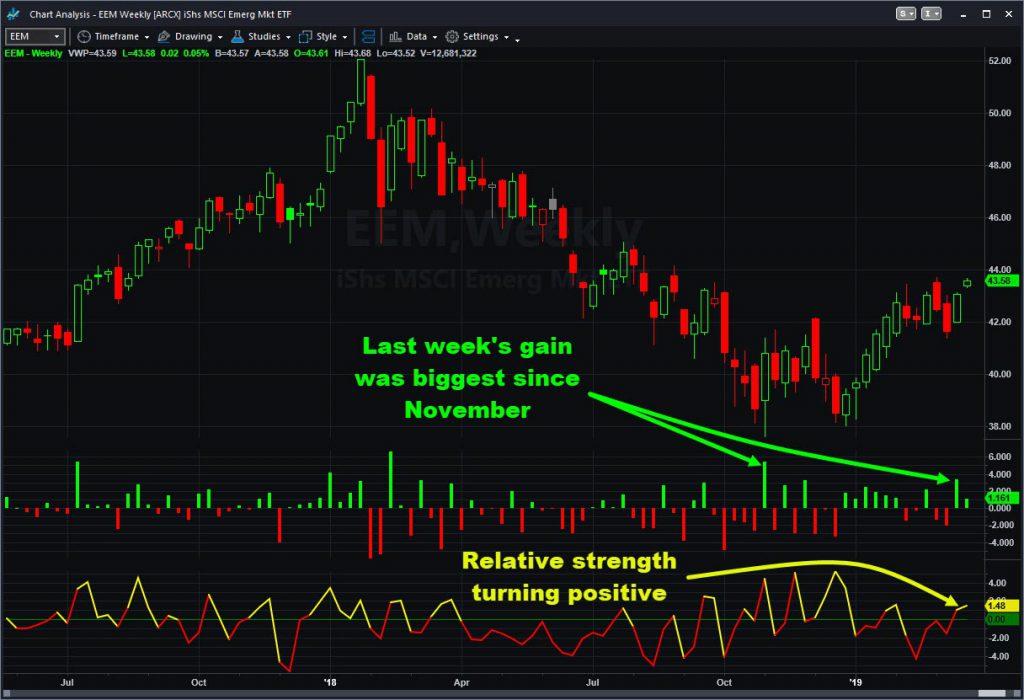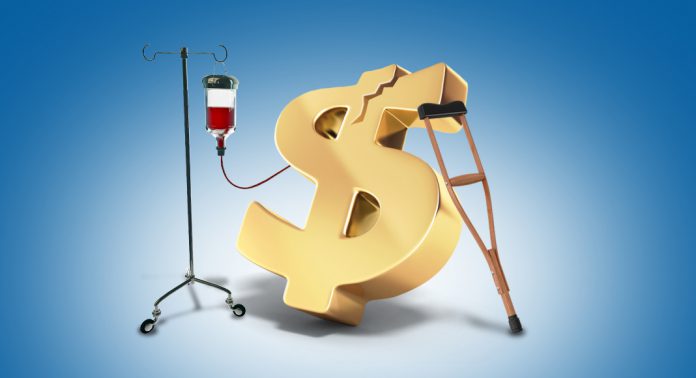The market’s embracing a “weak dollar” sentiment, looking for more easy money from Jerome Powell’s Federal Reserve tomorrow.
Copper (@HG), crude oil (@CL), silver (@SI) and gold (@GC) rallied earlier this morning before giving up some gains. Exchange-traded funds (ETFs) like the Vanguard International World (VEU) and iShares MSCI Emerging Markets (EEM) are also starting to outperform the S&P 500.
“With nothing in the outlook demanding an immediate policy response and particularly given muted inflation pressures, the Committee has adopted a patient, wait-and-see approach to considering any alteration in the stance of policy.” Those were Powell’s last comments about interest rates, made at Stanford University on March 8. They’re consistent with the Fed’s swift dovish turn in November.

iShares MSCI Emerging Markets (EEM), weekly chart, showing gains and relative strength vs. S&P 500.
Meanwhile, headlines at the global level have been positive or at least less negative. Here are a few, in no particular order:
- OPEC and Russia are committed to removing 1.2 barrels of oil from the market. Ministers even canceled their next meeting because they’re sufficiently on united on policy.
- Oil-inventory reports show tightening supplies. At the same time, domestic producers are slowing investments.
- Investors seem less worried about a bad Brexit outcome after a series of humiliating defeats for British Prime Minister Theresa May.
- Attention has shifted away from trade-war anxieties after President Trump delayed his meeting with China’s President Xi.
- Germany’s Zew survey of investor confidence rose more than expected today.
- Troubled financial giant Deutsche Bank (DB) is discussing a merger with Commerzbank. This could help remove one of the big issues plaguing Europe.
- Sentiment seems increasingly positive toward India as the giant Asian country heads to elections. Just this week, strategists at J.P. Morgan and Goldman Sachs issued bullish notes.
- Brazil keeps plodding toward reform under its new president. Last week, Bank of America Merrill Lynch reiterated an “overweight” rating on Latin America’s biggest economy.
In case you weren’t around last decade, here’s a simple way to understand “weak dollar” trades. Most assets are priced in the U.S. currency. When people want to buy commodities or global assets, they inevitably must sell the greenback.
Think of it like a fraction, with the U.S. dollar on the bottom. You can make it bigger by increasing the value of the top, or reducing the value on the bottom. Powell and other Fed officials have worked hard for months to reduce the value on the bottom.
Now, for the other reasons listed above, the market is starting to see more value on the top. Both trends support a weaker dollar and more value for “weak dollar” assets like commodities and foreign stocks.
In conclusion, we have more than a day before the Fed’s interest-rate decision. But at this point, the market may be starting to make up its own mind already.


























